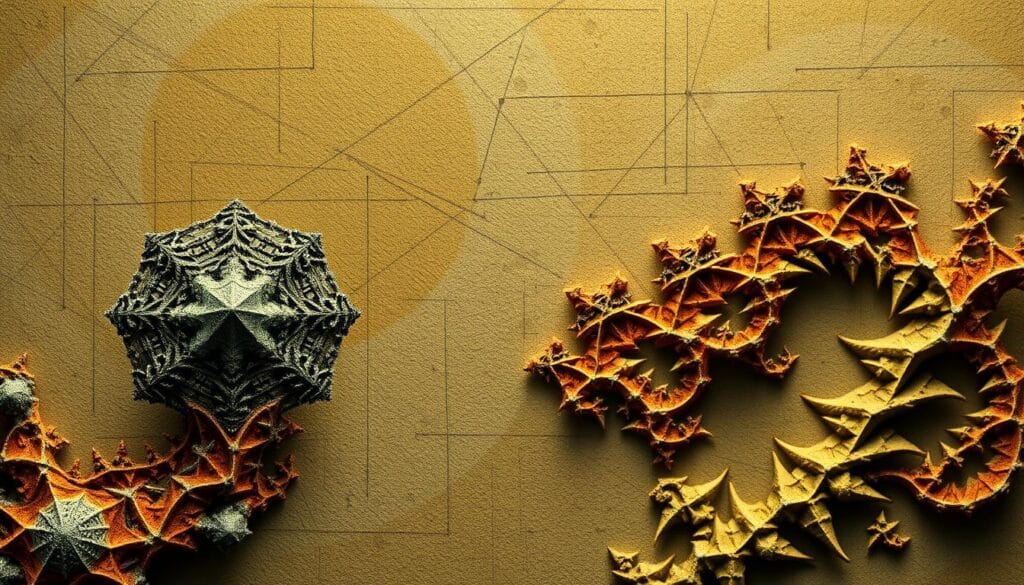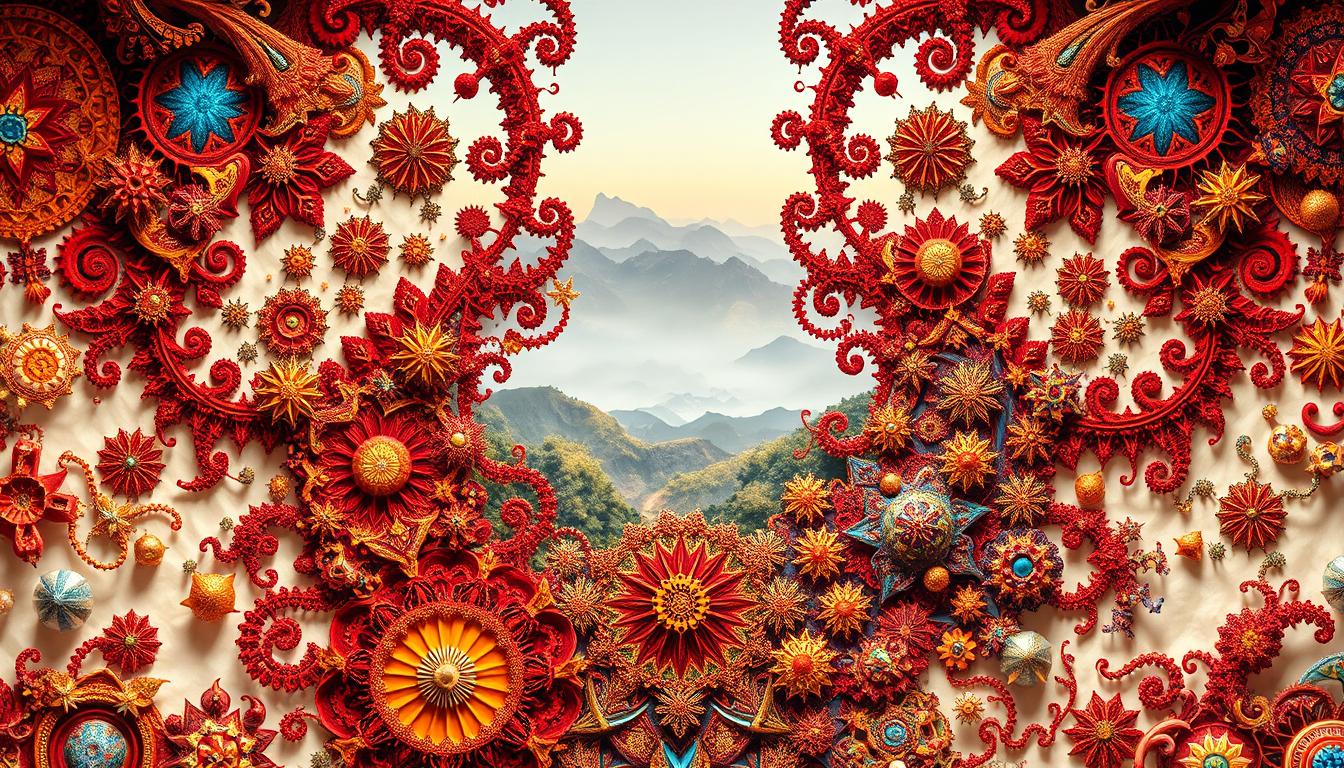Fractal design is key in developing indigenous architecture. It shows the culture and how people adapt to their environment. These shapes highlight the use of eco-friendly building methods.
This combination underlines buildings’ looks and usefulness. Studying this mix reveals how buildings and nature work together. It shows why sustainability is vital in modern designs.
Introduction to Fractals
Fractals are a captivating area of math, showing complex shapes with self-similarity at different sizes. They keep the same patterns no matter their size. This shows the mix of order and chaos in a visual way. Fractal geometry helps us study and grasp these complex patterns. It shows how small patterns reflect larger ones.
The use of fractals has grown a lot in the last 30 years. They have made a big impact in computer graphics, biology, and architecture. For computer graphics, they create stunning images that look like real landscapes. In biology, fractals help map things like blood vessels and the patterns of leaves. Their repeating nature lets scientists and artists examine intricate designs. These designs reflect both the natural world and human creativity.

Fractals show key ideas of recursion and scaling. Looking into these, we understand universal patterns found in nature and arts. This highlights how math connects to art.
The Significance of Fractal Design Principles in Indigenous Architecture
Fractals in indigenous architecture do more than please the eye. They are deeply embedded in the community’s culture, boosting identity and unity. Through fractal designs, cultural values shine in the way buildings are made. They help share traditions and connections in the architecture.
Indigenous groups often use fractal patterns to showcase their beliefs and ways of life. These designs reflect the nature around them and their collective hopes. This way of building creates a strong sense of community. It meets practical needs while celebrating cultural heritage and unity.
Indigenous architecture places a big emphasis on fractals to live in harmony with the environment. It shows how people and nature are connected, making sure buildings fit well in the landscape. This bond stresses the need for sustainable living, a key value in many indigenous cultures.
Understanding Fractal Geometry
Fractal geometry studies complex shapes and patterns. It includes self-similarity, where parts of a structure look like the whole. This idea is both interesting and useful in design.
Recursion shows how a shape can repeat at different scales. This helps in understanding relationships in architecture and nature. Scaling lets designers use fractal ideas for various sized structures, improving their looks.
Fractal dimensions help analyze shapes that can’t be measured by traditional geometry. Unlike standard geometry that uses clear measurements, fractal dimensions look at the complexity of irregular shapes. This lets architects create new and natural-looking buildings.
Understanding fractals allows architects and designers to make buildings that mirror mathematical principles and blend with their environments. It brings together mathematics and art. This opens up new avenues in architecture, challenging the usual ways of design.
Historical Context of Fractal Design in Indigenous Cultures
Fractal patterns in architecture showcase a strong tie to indigenous cultures globally. They have shaped buildings in communities like African societies and Native American tribes. These patterns are more than just pretty; they reflect the core beliefs and social connections of their creators.
Researchers have looked into how these designs show up in textiles and other creations. The ideas behind fractals highlight their importance in sharing stories and fitting into nature. For example, traditional building styles often use fractal geometry to show community life, values, and nature interactions.
Today, modern creators can learn from these ancient patterns. By reconnecting with indigenous practices, they can create new, respectful design ways. This approach could deepen our grasp of architecture’s growth, influenced by fractal use in history.
Fractal Design Principles in Indigenous Architecture
Indigenous architecture is a unique mix of form and function. It shows a deep relationship between them. The use of fractal recursion is key in these designs. It shows up in the structures of various communities. Patterns repeat at different sizes, linking big and small parts of a building. This not only looks good but also reflects the community’s stories.
Recursion in Structure and Form
Indigenous designs often have a repeating structure. For example, small patterns or carvings in homes can reflect larger forms. This creates a visual rhythm. It brings a feeling of belonging and connects all parts into one meaningful whole. It’s a way to celebrate and show cultural beliefs.
Scaling in Building Designs
How buildings are scaled is very important. It shows the relationship between the building, its environment, and what the community values. Indigenous designs blend with the land and weather while showing the community’s lifestyle. So, buildings are not just useful, but they tell a story about the people living in them.
Self-Similarity Across Different Scales
Indigenous architecture strongly uses the idea of self-similarity. This means homes and public areas share design elements. It helps strengthen the community’s identity. From small huts to bigger places, a common style is maintained. This makes everyone feel included and part of a larger family.
Case Studies of Fractal Architecture in Africa
African fractal architecture shows how design reflects cultural values and social structures. By looking at case studies, we see fractal patterns in many forms and functions across Africa.
Logone-Birni: A Fractal Urban Landscape
Logone-Birni in Cameroon has a unique urban layout. Its streets and public spaces showcase repeated patterns. This design improves connectivity and strengthens community ties.
Ba-ila: Circular Settlements of Southern Zambia
The Ba-ila’s circular settlements show a deep understanding of fractals. This design mirrors their social structure, with families in a circular pattern. It shows the community’s support and interconnectedness.
Nankani: Cylindrical Homes and Their Symbolism
In Nankani, cylindrical homes are more than just buildings; they symbolize life’s cycles. They reflect the inhabitants’ values and connection to culture and nature. This highlights the stories indigenous settlements tell through architecture.
Mokoulek: The Architecture of Defense and Community
The Mokoulek region’s architecture focuses on defense and community. Structures are set up to protect and encourage interaction. This shows a balance between safety and community unity.
Fractals Beyond Africa: Global Perspectives
Fractals aren’t just used in Africa. They’re part of designs all around the world, including Native American architecture. Here, they show a deep bond with nature and the community. The designs often reflect the landscape, creating a balance with the surroundings.
In Asia, buildings also follow this pattern. Japan’s traditional houses use fractals to keep cool and promote airflow. Pagodas display these principles too, with each level mirroring the entire structure.
Europe sees fractals in modern architecture as well. Antoni Gaudí, a famous architect, included natural shapes in his urban projects. This helped blend tradition with modern needs. His designs foster social interaction and community spirit.
These examples from around the world show that fractal designs are everywhere. They help raise environmental awareness and promote innovation. By using fractals, societies can respect their past while solving modern problems.
The Influence of Indigenous Fractal Patterns on Modern Architecture
Indigenous fractal patterns have become a major inspiration in today’s architecture. These designs show a deep understanding of nature and community ties. They carry old cultural stories that match modern values. Now, architects often use these fractal designs in their work.
Adding traditional fractal ideas makes buildings look better and helps the environment. This method underlines the need to live in harmony with our surroundings. Such projects show the beauty of fractal designs. They make spaces that bring people together and raise environmental awareness.
Many new buildings show these ancient techniques. They often have repeating patterns that mimic natural shapes, showing a link to cultural roots. Architects who use these designs help communities by combining old and new. They encourage smart building methods.
Environmental Advantages of Fractal Building Designs
Fractal building designs boast big environmental benefits. They closely follow sustainability rules. By using natural airflow, they cut down on the need for man-made heating and cooling. This lowers how much energy they use. The unique layouts from fractal geometry make more room and fight against crowded cities. They also help protect different kinds of plants and animals.
These designs shine when you look at how ecologically efficient they are. They blend well with their surroundings, which looks good and saves resources. Fractal buildings make it easier for people to live in a way that cares for the Earth. They encourage us to live in harmony with the world around us.
Challenges and Opportunities in Implementing Fractal Principles Today
Bringing fractal principles into modern architecture is tough. Today, there’s a big focus on traditional shapes, making it hard to try new designs. Architects often meet resistance from those who like classic styles more than the new, intricate patterns of fractals. This struggle is made worse by a general lack of understanding about fractal principles. This makes it hard for these ideas to be widely accepted in building designs.
But, there are still chances to use fractals in architecture, thanks to tech advancements. Tools like parametric design and 3D modeling help architects experiment with fractals easier. This makes it simpler to include fractal elements in their work. With the help of cutting-edge software, architects can mix old wisdom with new methods.
To make the most of these chances, we need to think differently about building designs. Talking with experts who know how important fractals are can help. It can make more people see the value and beauty of fractal designs. Highlighting the environmental benefits and unique look of fractal structures can make architects want to use them more.
Conclusion
Studying fractal design in native buildings offers a deep look at its importance. It shows how closely culture and adapting to the environment are linked. By learning from these patterns, architects better grasp how buildings show community values and identity.
Looking forward, the insights from fractal designs guide us toward building sustainably. This approach balances respect for traditions with new ideas. It mixes old wisdom with new techniques, opening doors to improve our living areas while remembering our history.
Merging fractal principles with today’s architecture brings a new appreciation for our surroundings. It blends cultural importance with modern needs. This way, the stories of native communities are kept alive in today’s buildings.



